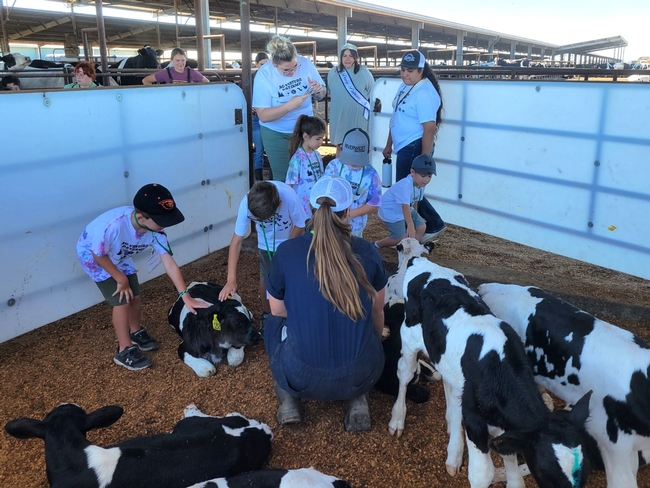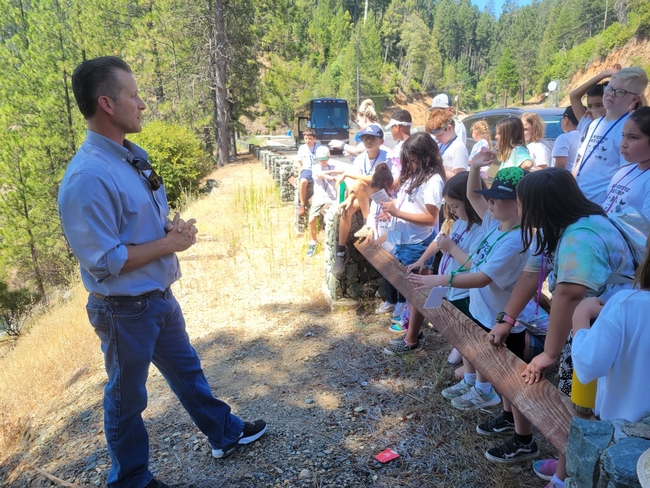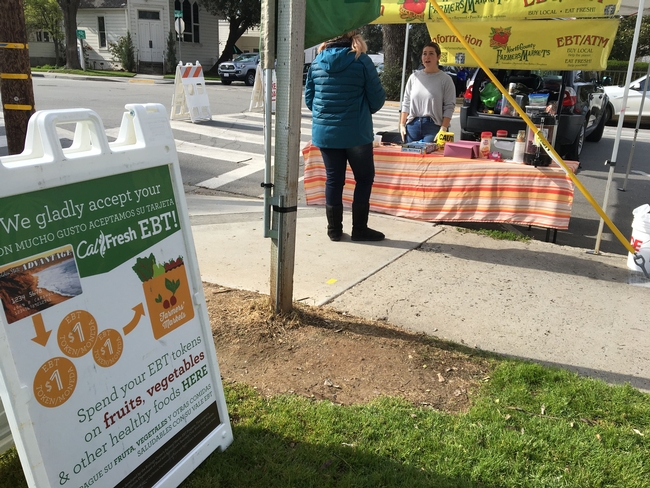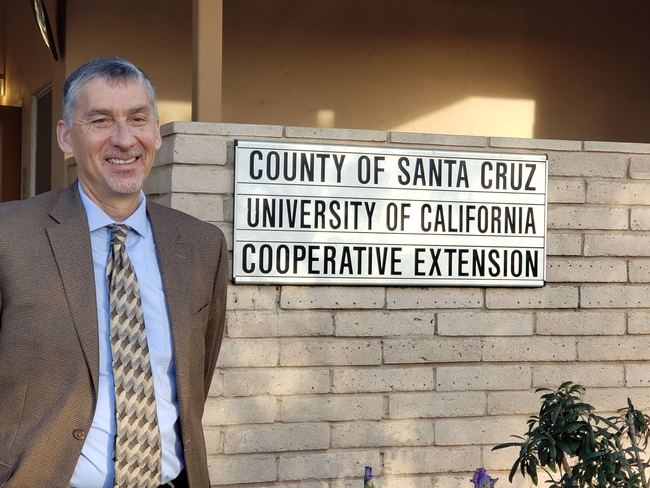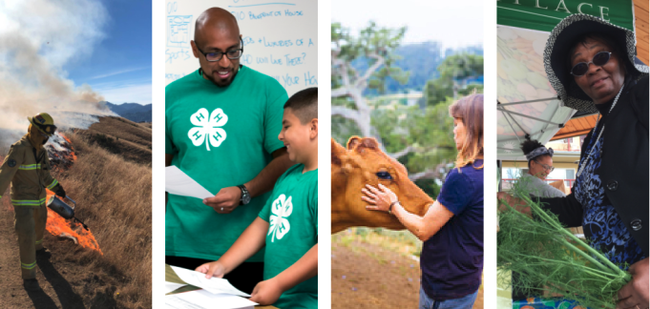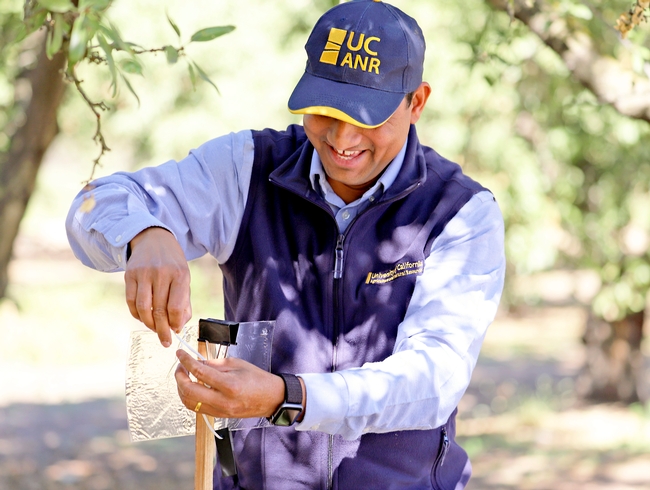Posts Tagged: Cooperative Extension
Ag-Venture campers dive ‘head first’ into agriculture, natural resources
UC Cooperative Extension team in Sutter and Yuba counties showcases UC ANR programs, community partners
When dozens of elementary schoolers gathered to watch a live calf birth at Tollcrest Dairy in Yuba County, their comments ranged from “disgusting but cool” to “I saw something that maybe I'm too young to see.”
Expanding horizons, growing knowledge and gently pushing some limits were at the heart of a four-week day camp, Ag-Venture, organized by the University of California Cooperative Extension office serving Sutter and Yuba counties.
Throughout July, more than 80 campers – ages 5 through 12 – explored agriculture and science topics through field trips across the region, hands-on activities and lively presentations by UCCE advisors, UC Master Gardeners, 4-H specialists, UC Master Food Preservers and CalFresh Healthy Living, UC educators. All these groups fall under the umbrella of UC Agriculture and Natural Resources.
A grant from The Center at Sierra Health Foundation funded this day camp for underserved youth focused on agriculture and natural resources – the first of its kind in the area. Exploring the themes of “Interesting Insects,” “Foods and Farms,” “Woods and Water” and “Awesome Animals,” the campers learned directly from community experts and UC ANR scientists.
“Some of the kids might think scientists are only wearing lab coats and working with genetics and DNA and human-based science, but here they got to see agricultural scientists and natural scientists,” said Rayna Barden, the 4-H community education specialist who led the camp. “It was a cool way to showcase what ANR does and what we have to offer.”
Youth gain wide range of experiences, knowledge
Visits to local farms and ranches – with many chances to greet the animals – were a highlight for many of the camp participants.
“I liked learning about agriculture and the interactive activities,” said a fourth grader. “I saw a baby cow coming out of its mama, and they [farm staff] had to use a tool. It was cool.”
A sixth grader said: “I learned that feed is made up of everyday items, like almond shells and beer hops!”
“Sheep, cows and goats have one stomach and four chambers,” added another sixth grader.
That digestive tidbit was absorbed by the campers after a visit with UCCE livestock and natural resources advisor Dan Macon at Sierra Foothill Research and Extension Center, a facility operated by UC ANR in Browns Valley.
“We have 4-H kids and FFA kids in high school who still don't know how the four chambers work!” Barden said. “These kids had it and it was so cool to see that they remembered that from a previous day.”
Time and time again, Barden said she was amazed at how much the campers retained. After a visit to Bullards Bar Reservoir, a seven-year-old was able to explain why the dam is curved. Another young boy could draw his own interpretation of the water cycle. And several campers talked about the rice presentation for weeks.
Whitney Brim-DeForest, UCCE county director for Sutter and Yuba counties and a rice advisor, had the participants touch and feel different rice seeds and varieties. The campers also got to plant a few rice seeds to take home.
“But their favorite part – and what they talked about for the rest of camp – was the tadpole shrimp,” Brim-DeForest said. “We brought some live and preserved specimens, and they loved them!”
Sparking ideas for future careers
One third-grade camper said she enjoyed learning the differences between agricultural pests and beneficial insects.
“And you can do stuff to help the good bugs,” she said, adding that she would like to pursue a career working with animals and nature.
Expanding awareness among young people of new career possibilities was exciting for Ricky Satomi, UCCE forestry and natural resources advisor for Sutter and Yuba counties. Using interactive exercises (such as those developed by California Project Learning Tree, another UC ANR-affiliated program), Satomi shared his knowledge about resource competition, watershed filtration and fire behavior in forest ecosystems.
“It's always a pleasure to introduce students to the natural resources where they live,” Satomi said. “This is particularly critical given the current workforce shortage we face in forestry; I hope their experience at Ag-Venture will spark interest in future forestry careers, where these students can work to better their local forest communities.”
Young people from local colleges and universities also gained invaluable experience during the camp. Four students helped prepare the camp: Yasmeen Castro Guillen (Chico State), Alana Logie (Yuba College), Jayla Pollard (Folsom Lake College) and Adam Yandel (Chico State). Three more helped lead the camp as counselors: Hector Amezcua (Yuba College), Alyssa Nott (Butte College) and Jillian Ruiz (Chico State).
“They did such a fantastic job, mentoring the kids and serving as positive role models, and we have seen tremendous growth in all of them, too – in confidence, skills and knowledge,” said Brim-DeForest.
A true community effort
Barden emphasized that the sweeping scope and in-depth, intertwining lessons of the camp were only possible through broad support from the greater community. Brim-DeForest highlighted the partnership with Yuba City Unified School District, as well as with Sutter County. Camp HQ was in Ettl Hall, a Sutter County building; campers visited the Sutter County Museum; they also met Yuba-Sutter public health officer Dr. Phuong Luu.
Additional collaborators included Melissa Ussery, CalFresh Healthy Living, UC nutrition program supervisor; Rene McCrory, 4-H secretary; Johnny Yang, UC Master Gardener and Master Food Preserver program coordinator; Matt Rodriguez, 4-H youth development advisor; and Nicole Marshall-Wheeler, 4-H youth development advisor.
“Honestly, we could plan all of this, but without the community's support, our program never would have worked smoothly,” said Barden, who grew up in the small town of Sutter. “Having all of our guest speakers, having all the people who were willing to have up to 50 kids on their property – it just shows how much our community is about our youth.”
Brim-DeForest said Sandy Parker, the camp nurse, exemplifies that spirit. A UC Master Gardener and 4-H alumna and volunteer, Parker also invited the campers to her family ranch, where she introduced the children to her farm animals and Great Pyrenees guardian dog.
The campers certainly appreciated the generosity, teamwork and energy that went into Ag-Venture. Barden said that many of the participants originally had only signed up for one or two weeks – but loved the camp so much that they asked to register for more. And she added that the “vast majority” of them said they want Ag-Venture to come back and would attend in the future.
“Our youth are just so resilient and so willing to learn,” Barden said, reflecting on the camp overall. “Whereas adults, we're usually a little more timid at things, these kids just were willing to dive in, head first, and be in that moment and try to take away as much as they could from what they were offered there at camp.”
UC ANR experts offer counsel as CalFresh benefits shrink, participants face hunger
Reduction of SNAP benefit deepens crisis of inflation, high cost of living, low wages
Starting this month, many of the estimated 3 million people in the CalFresh program – California's version of SNAP (Supplemental Nutrition Assistance Program) – will be facing hunger and making difficult decisions to meet their most basic needs. In late March, participants received the last of the pandemic-related emergency aid that significantly boosted their monthly benefits. The reduction varies by household size and income; for example, in April a single-person household could see a drop from $281 per month to $23.
“The emergency food allotments had a tremendous impact in our communities and across the nation,” said Shannon Klisch, academic coordinator for the Youth, Families and Communities Program for UC Cooperative Extension in San Luis Obispo and Santa Barbara counties. “One study estimated that these allotments kept more than 4 million people out of poverty across the U.S. in the last quarter of 2021, and reduced child poverty by 14%.”
SNAP increases during the pandemic made many Californians more food-secure, with some participants reporting that their allotments finally had been enough to feed their families for the month, according to Wendi Gosliner, a project scientist at the Nutrition Policy Institute (a program of UC Agriculture and Natural Resources). But, with the benefit reductions, food insecurity is emerging again as a serious concern.
“It is inconceivable that a nation this wealthy should have so many people experiencing hunger,” Gosliner said. “And here in California, with the high cost of living, ongoing inflation and extreme income and wealth disparities, people are being forced to explore every possible avenue just to feed themselves and their families.”
To help ensure they are receiving the maximum allotment, Klisch recommends that CalFresh participants – especially those who applied during the pandemic and are relatively new to the program – double-check their information.
“If the county doesn't have your most up-to-date information, call your county worker if you've changed your address, if you've experienced decreased income, if your housing costs have gone up, or if you have new expenses – like child or dependent care expenses or medical expenses – these can help you qualify for more CalFresh funds,” she explained.
For families with school-aged children, Klisch said they can stretch their food dollars and promote healthy eating by encouraging their children to eat breakfast and lunch at school through California's universal free school meals, and all families with children under 18 can watch for the next issuance of the P-EBT (Pandemic EBT) card, worth potentially hundreds of dollars.
In addition to these options for food assistance, Klisch pointed to programs that can help people save money on other household expenses, such as California Alternate Rates for Energy Programs (CARE) and Affordable Connectivity Program. Local food banks are also gearing up across the state to handle an expected surge in clients in need of emergency food; a list of California food banks can be found at cafoodbanks.org/our-members.
“We ask a lot of low-income families and workers to navigate and piece together various programs, applications, and benefits when we don't commit to a strong safety net,” Klisch said. “On the other hand, when people have enough money for food, everyone benefits through decreased health care costs and increased economic activity.”
Gosliner also said that people should look into their eligibility for WIC (Special Supplemental Nutrition Program for Women, Infants and Children), as well as the federal Earned Income Tax Credit (EITC) and CalEITC, poverty-alleviation benefits underused by Californians.
“People should make sure they are accessing all the safety net benefits for which they are eligible,” Gosliner said.
Market Match, other nutrition incentive programs can help
Through programs like Market Match, available at about 300 farmers markets across California affiliated with the Ecology Center, CalFresh participants can have their EBT benefits “matched” by their local market (usually up to $10 or $15 per visit).
“People are looking to get creative about how to stretch their food dollars, and Market Match is one way to do that,” said Klisch, who has led UCCE efforts to help promote the program along the Central Coast since 2017.
Striving to expand access to fresh fruit and vegetables and to support local farms, UCCE and CalFresh Healthy Living, UC worked with partners to increase CalFresh redemption at farmers markets in San Luis Obispo and northern Santa Barbara counties.
In 2017, about $48,000 in CalFresh and Market Match benefits were redeemed at farmers markets in the area. In 2022, the total was more than $207,000 – a 327% increase. According to Ecology Center figures for the entire state, CalFresh and Market Match spending at farmers markets jumped 161% from 2019 to 2021, up to $13 million.
Gosliner, whose research has shown that these nutrition incentive programs are associated with increased food security, noted that “the people who use Market Match absolutely love the program and feel it is incredibly helpful.” She also added that the California Department of Social Services is developing a pilot program that would offer match incentives for purchasing fruits and vegetables at larger food retailers.
Although the biggest of its kind, Market Match is just one of the programs across California that provide “matches” for healthy food purchases under the California Nutrition Incentive Program, which in turn is primarily funded by GusNIP (the nationwide Gus Schumacher Nutrition Incentive Program).
GusNIP dollars – and SNAP overall – are governed by the federal Farm Bill, typically renewed every five years and currently being negotiated by Congress.
Fewer than 10% of patients screened for food insecurity during pandemic
Study finds even fewer screened during virtual appointments
As jobless rates rose during the COVID-19 pandemic, millions more Americans experienced food insecurity because they lacked consistent access to food. National health organizations recommend primary care providers screen patients for food insecurity, since not having access to enough food can lead to chronic diseases.
But research from the University of California, Davis, finds that only 7% of primary care providers screened patients for food insecurity. If the appointment was virtual or telehealth, only 3% asked patients about their access to food. The American Journal of Preventive Medicine published the research.
“These rates are surprising and seem relatively small in comparison with what seems like a growing awareness of food insecurity during the pandemic,” said lead author Cassandra Nguyen, an assistant professor of Cooperative Extension in the UC Davis Department of Nutrition.
She said the findings may indicate that health care providers were prioritizing emergency responses to COVID-19. The research showed that once people had access to COVID-19 vaccines, screening for food insecurity increased to 10%.
Barriers to telehealth screenings
Screening for food insecurity at telehealth appointments remained low even after vaccines became available. Nguyen said that may suggest telehealth appointments have unique barriers.
“One of those barriers could be a concern about privacy and whether the patient is alone or feels comfortable discussing a potentially stigmatizing experience such as food insecurity. This may deter a primary care provider from asking about it,” Nguyen said.
Screening might also be more difficult if patients aren't familiar with the technology needed or if there are technological disruptions during telehealth appointments. Nguyen said more study is needed about potential barriers given the increased popularity of telehealth appointments since the pandemic.
The research examined electronic health records and clinic data from a national network of more than 400 community health centers in 16 states. It examined encounters between March 11, 2020, and Dec. 31, 2021. Screening typically involves a primary care provider asking the patient to answer that either or both of the following two statements is often true or sometimes true:
- Within the past 12 months we worried whether our food would run out before we got money to buy more.
- Within the past 12 months the food we bought just didn't last and we didn't have money to get more.
Co-authors include Rachel Gold with OCHIN Inc. and Kaiser Permanente Northwest Center for Health Research; Alaa Mohammad, Dedra Buchwald and Clemma Muller with Washington State University; Molly Krancari, Megan Hoopes and Suzanne Morrissey with OCHIN Inc.
The National Center for Advancing Translational Sciences of the National Institutes of Health, and the National Institute of Diabetes and Digestive and Kidney Diseases supported the research.
Gonzalves begins as new UC Cooperative Extension director for Monterey, Santa Cruz and San Benito counties
David Gonzalves started on Feb. 1 as director for University of California Cooperative Extension in Monterey, San Benito and Santa Cruz counties. UC Cooperative Extension connects communities across California with UC research and science-based solutions through agriculture, natural resources, nutrition and 4-H youth development programs.
Responsible for the overall operation of UCCE educational and applied research programs in the region, Gonzalves also will build and expand partnerships with county and city governments, public agencies and community organizations.
“David brings tremendous expertise in administration, fostering strong relationships, and building effective teams,” said Deanne Meyer, interim associate vice president for programs and strategic initiatives at UC Agriculture and Natural Resources, which administers UCCE statewide. “His track record of engaging local agencies, business partners, stakeholders and community groups will be invaluable as we explore new collaborations to reach and serve more Californians.”
Gonzalves was most recently a campus building official at UC Merced. Beginning his career at the County of Merced as a fire inspector, Gonzalves worked his way up to supervising building inspector and eventually assistant development services director. Then, for the City of Merced, he filled the role of chief building official and ultimately director of development services, leading the city's Building, Planning and Engineering teams. For three years, Gonzalves served as Tuolumne County's Community Resources Agency director.
“David's past experience as an administrator in county government and at UC Merced makes him the ideal candidate for the work we do at UCCE, as he has demonstrated success in being able to successfully negotiate these two worlds,” said Lynn Schmitt-McQuitty, interim director for county Cooperative Extension at UC ANR.
Gonzalves said he looks forward to meeting with county leaders, members of local boards, growers, UC Master Gardener volunteers, 4-H members and community members to learn how UC Cooperative Extension can help meet local needs.
“My big picture goal is to allow UCCE advisors, administrative teams and local county leaders to have a coordinated approach to our local challenges and successes,” Gonzalves said. “Our efforts will concentrate on freeing up our research teams' calendars to ensure they can continue producing cutting-edge accomplishments here in the tri-county area.”
Based at the UCCE Monterey County office in Salinas, Gonzalves can be reached at dgonzalves@ucanr.edu or (831) 392-5916.
UC ANR to hire 48 more UC Cooperative Extension advisors
From Del Norte, Siskiyou, and Modoc counties south through San Diego and Imperial counties, Californians will be seeing more University of California Cooperative Extension advisors in their communities.
University of California Agriculture and Natural Resources has released 48 more UCCE Advisor positions for recruitment over the next 12 months thanks to increased 2021-22 state funding. This brings the total to 89 new UCCE Advisor positions since July 2021 when Gov. Newsom and the state Legislature provided a historic budget boost for UC ANR. During the last six months of 2021, UC ANR released 41 other UCCE positions that have been filled or are under recruitment. The full list of UCCE positions is posted online at https://bit.ly/CEpositions2021-22.
Additional UC Cooperative Extension Specialist positions will be announced for recruitment in early April 2022.
“We appreciate the people across the state who worked with UCANR to develop the UC Cooperative Extension advisor position proposals,” said Glenda Humiston, University of California vice president for agriculture and natural resources. “Input from community members and partnering agencies and organizations was critical to informing the prioritization of these UCCE positions. Now we hope our supporters will help us recruit the best scientists to work with California's communities.”
The new UCCE advisors will be providing research-based information to residents about nutrition, community development, crop production, forestry, pest management, water management, youth development, landscape management and wildfire.
In addition to traditional issues, some of the new UCCE advisors will be focusing on climate adaptation for Indigenous farmers, cultural burning and Indigenous land stewardship, repurposing green waste, and community development with Californians who are Black, Indigenous or speak English as a second language.
The following UCCE Advisor positions will be staged for recruitment to avoid overwhelming UC ANR's Human Resources colleagues:
- 4-H Community Engagement & Development Youth Area Advisor for Tulare, Fresno and Kings counties
- 4-H Animal Science Youth Advisor for San Benito, Monterey and Santa Cruz counties
- 4-H Youth Development Area Advisor for San Diego and Orange counties
- Agronomy and Weed Management Area Advisor for Merced County
- Agronomy and Weed Science Area Advisor for Tehama, Glenn and Shasta counties
- Climate Resilient Indigenous Farming and Food Sovereignty Area Advisor for San Diego and Riverside counties
- Community Development BIPOC (Black, Indigenous, and other people of color) Advisor for Alameda, Contra Costa, San Mateo and San Francisco counties
- Community Health and Nutrition Advisor for San Joaquin, Stanislaus and Merced counties
- Community Health and Nutrition Advisor for Shasta, Trinity and Tehama counties
- Community Health, Nutrition and Food Security Area Advisor for Butte, Glenn, Colusa, Sutter and Yuba counties
- Community Health, Nutrition and Food Systems Area Advisor for Siskiyou, Modoc and Lassen counties
- Community Health and Nutrition Older Adult Area Advisor for Marin, Napa and Sonoma counties
- Cultural Burning and Indigenous Land Stewardship Advisor for Mendocino and Lake counties
- Dairy Area Advisor for Tulare and Kern counties
- Entomology Area Advisor for Ventura and Los Angeles counties
- Environmental Horticulture Area Advisor for Fresno, Madera, Tulare and Kings counties
- Environmental Horticulture and Forestry Area Advisor for Placer and Nevada counties
- Environmental Horticulture and Water Resource Management Area Advisor for Alameda, Contra Costa, San Mateo, Santa Clara and San Francisco counties
- Food Safety and Organic Production Area Advisor for Imperial and Riverside counties
- Forestry Area Advisor for Santa Cruz, San Mateo and Santa Clara counties
- Forestry Area Advisor for Shasta, Trinity and Siskiyou counties
- Fruit and Almond Area Advisor for Fresno and Tulare counties
- Horticulture and Specialty Crops Advisor for Humboldt and Del Norte counties
- Indigenous Disaster Resilience Planning and Policy Area Advisor for Amador, Calaveras, Tuolumne and El Dorado counties
- IPM (Integrated Pest Management) Area Advisor for Amador, Calaveras, Tuolumne and El Dorado counties
- IPM Entomology Area Advisor based at Kearney Research and Extension Center
- IPM Entomology Farm Area Advisor for Monterey, Santa Cruz and San Benito counties
- Intermountain Irrigated Grass Systems Area Advisor for Modoc, Shasta and Lassen counties
- Irrigation and Soils Area Advisor for Stanislaus, San Joaquin and Merced counties
- Livestock and Natural Resources Area Advisor for Amador, Calaveras, Tuolumne and El Dorado counties
- Orchard Systems and Weed Ecology Area Advisor for Glenn, Tehama and Colusa counties
- Organic Materials Management Area Advisor for Orange, Los Angeles and San Diego counties
- Organic Materials Management and Agri-Food System Area Advisor for Santa Clara, Alameda, Contra Costa, San Mateo and San Francisco counties
- Pathology Area Advisor for Imperial, Riverside and San Diego counties
- Production Horticulture Area Advisor for Ventura and Santa Barbara counties
- Restoration Ecology and Weed Science Area Advisor for Kern, Tulare and Kings counties
- Rice Farming Systems Area Advisor for Colusa and Yolo counties
- Sustainable Agriculture Systems Area Advisor for Mariposa, Merced and Stanislaus counties
- Sustainable Orchard Systems Area Advisor for Sutter, Yuba, Butte and Placer counties
- Urban Agriculture Food Systems and Environmental Issues Advisor for San Diego and Orange counties
- Urban IPM Area Advisor for Sacramento, Solano and Yolo counties
- Urban Watershed Resilience Area Advisor for Orange, Riverside, San Bernardino and Los Angeles counties
- Vegetable Crops Area Advisor for Sacramento, Solano and Yolo counties
- Water and Soil Resources Area Advisor for Sonoma, Marin, Napa and Mendocino counties
- Water Management Area Advisor for Tulare, Fresno, Kings and Madera counties
- Water Quality-Quantity-Climate Change Area Advisor for Mendocino and Lake counties
- Weed Ecology and Management Area Advisor for Fresno, Tulare and Kings counties
- Youth, Families and Communities Area Advisor for Kern, Inyo and Mono counties



